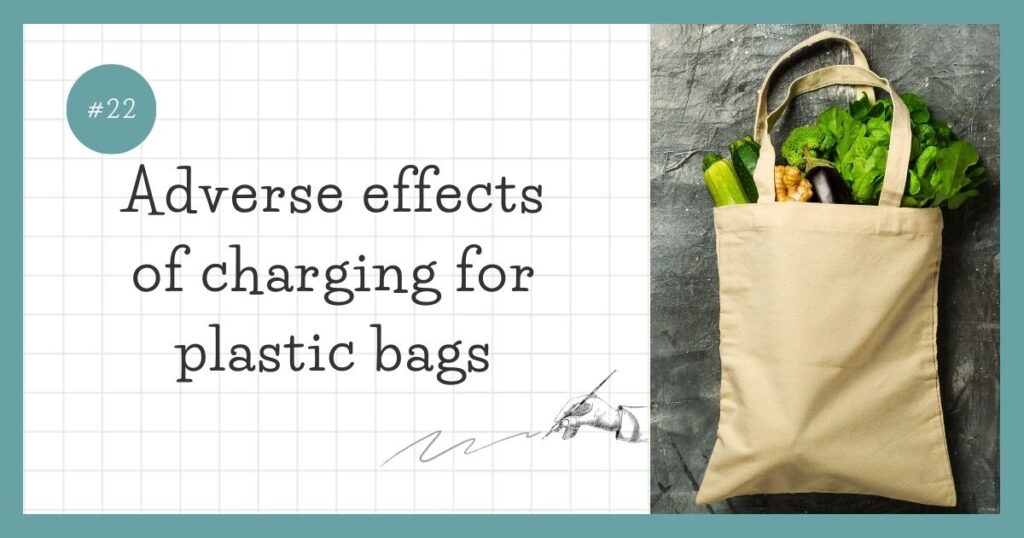
Suggestions for shut-ins
A customer is complaining to the clerk at a crowded convenience store during lunch time.
It seems that they are angry because his heated lunch boxes are too hot to hold, and they want free plastic bags.
This dynamic proposal ignores the trend toward charging for plastic bags that began in July 2020.
He must have been cooped up at home for 3 years and 6 months, isolated from the social trend to care for the natural environment.
To the clerk who explains in an annoyed tone that “the plastic bag for lunch is 5 yen”, the customer shouts out what everyone in the line is thinking: “5 yen is expensive; if you buy two bags, they cost 10 yen!“.
I don’t understand the meaning of emphasizing the very natural fact that two pieces cost 10 yen, since the bento he purchased was only one piece.
This is customer harassment, isn’t it?” The people in the checkout line began to murmur.
I don’t know if he was impatient with this comment or couldn’t bear to look around, but he said, “I’ll never come here again!” he lashed out at the clerk and left the store with his lunch box in hand.
During the dispute, the microwaved hot bento must have cooled down a little to a temperature where he could hold it with my bare hands.
There are approximately 58,000 convenience stores in Japan and 7,400 in Tokyo.
There are several convenience stores within a few minutes’ walk of this store, so there is no need to bother visiting the store that made so much noise.
In the first place, all the clerks who had a bad experience and all the customers who had to wait at the cash register should have muttered in their hearts, “Don’t come back!” in their hearts.
Things that bother me
I usually carry a foldable eco-bag in my bag, but it does not hold lunch boxes or other items with a wide bottom gusset, so I frequently buy plastic bags.
Of course, I don’t curse the clerk for the ¥5 plastic bag, but there are times when I feel annoyed depending on the product.
For example, when I buy my favorite Krispy Kreme doughnuts, “Original Glazed Doughnuts (12 pieces).
Not many people carry an eco-friendly bag that can carry a rectangular box of 12 doughnuts, four horizontally and three vertically, without tipping it.
Krispy Kreme Doughnuts offers a rare “buy one dozen, get another dozen” god-like promotion, but I doubt they would ask me, a non-Uber Eats delivery person, if I would buy a plastic bag that could carry two boxes horizontally.
The same goes for cakes, which require wide bottom gussets and tall eco-friendly bags.
With Original Glazed, it is not so much of a problem if the donuts move around a bit in the box, but if the cakes are not carried home in a horizontal position, they will lose their shape and you will be disappointed when you eat them.
Cake stores that employ carry boxes without handles should eliminate the option of not attaching a plastic bag, as they should be selling their cakes on the assumption that they will be placed in a plastic bag.
How much do you love doughnuts!” I might be scolded, but Mister Donut also hands you a paper bag with no handle, depending on the product I am buying and the number of items, but it is difficult to carry it back home if I have other luggage.
The doughnuts currently being sold are a collaboration with Godiva, but when other people have Mister Donut boxes, it reminds them of the commercials and they want them.
Now that there is a charge for paper bags, even for non-food items, and more people are packing their products in larger own bags to take home, retailers have lost the promotional effect that plastic and paper bags have potentially had on consumers.
This is probably a big loss for companies as well.
After purchasing a coveted brand-name product at a department store, putting it in one’s own bag will take away the elation of shopping, and the act of making consumers purchase paper bags for pricey products that cost from several tens to a hundred yen seems to miss the point.
Stores that value the promotional effect and shopping experience that a product bag provides still do not ask for the cost of a to-go bag.
This would lead to the tacit understanding that mass-marketed or low-priced products will charge for plastic bags, and only companies that handle such products will be able to reduce costs by loudly emphasizing “We are aiming for a sustainable society!” and promoting cost reduction is ridiculous.
It is time for the government ministries and agencies to clarify whether to charge for all plastic and paper bags or to leave it up to retailers to determine whether to charge for certain products or not.
Station Bento and Handbag
Ekiben, which offer local specialties, are a pleasure for travelers.
Each boxed lunch box is filled with gorgeous ingredients and makes me feel happy when I open the lid.
The other day I bought a makunouchi style bento on a business trip, but since one hand was full with my business bag, I had to buy a plastic bag if I bought the bento with green-tea.
I had to take out my ticket in front of the station ticket gate, put it in the ticket slot, and enter the station, but I could not carry the plastic bag on my elbow during this process.
If the boxed ekiben are packed with a lot of ingredients, such as the popular Kiyoken “Chinese dumpling soup bento” and Shinkineya “Beef Domannaka bento,” you may be able to manage to put them vertically in your business bag, but most other bento will be in a miserable state.
Also, when working on the train, the finished bento box is in the way.
I keep my empty lunch box in the pocket in front of my seat with a plastic bag tied inside, and throw it away in the trash on the platform at the alighting station.
I have been doing this as a habit for a long time, and the plastic bag is as inseparable from my lunch box as green-tea.
Needless to say, I can throw away the lunch box I have finished eating in the trash bin installed in the train, but it is a hassle to put my computer and smartphone, which are plugged into the electrical outlet in the train, back in my bag, and go to the trouble of carrying my lunch box, plastic bottle, and bag all the way to the station.
As mentioned in the article “Bay Shuttle Connecting Osaka and Kobe in 30 Minutes,” I once went to the restroom on the train and returned to find a complete stranger sitting in my assigned seat.
Sometimes I see people leave their bags and computers on their seats or luggage racks, bringing only their wallets and cell phones, but I can’t do it. I’m too anxious to go to the bathroom.
Nowadays, pants can be bought anywhere, even at convenience stores. I would rather be incontinent than have my luggage stolen.
An old man sitting next to me on the Shinkansen had a boxed lunch box in his knitted pocket in front of his seat, and I was concerned that “the juice from the ingredients might stain his knitted pocket.”
The Shinkansen arrived at the last station and had only seven minutes to clean up before departing again.
It would be possible to overlook the possibility that the woven pocket in front of the seat might be soiled with juice from the lunch box ingredients.
Wouldn’t it be more efficient to put plastic bags on the lunchboxes sold at the station than to receive complaints about soiling the baggage of the next passenger, such as books?
While it is understandable to reduce resources and coexist with a sustainable society, some products should be sold at a price that includes the plastic bag.

